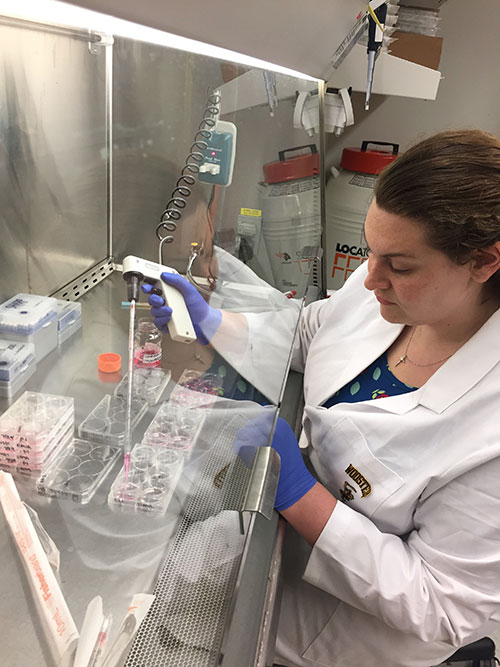
Bad to the Bone or Good for Healing?

Hannah Sexton knew from the moment she arrived at Wooster as a first-generation college student and aspiring biology major that she wanted to do some sort of research involving bones. “It’s such a dynamic system,” she says, “when you think about how much it does for us on a daily basis, and how devastating bone loss or injury can be to your everyday functioning.” Moreover, bones “are not the stable structure we think of, they’re constantly wearing away and renewing themselves.”
So, when her mother forwarded her a Facebook post about Kurt Hankenson, a researcher at Michigan State University whose lab had been awarded a $1.7 million Department of Defense grant to investigate ways to improve the healing process for fractured bones, Sexton emailed him to ask about summer research opportunities. One of the post-docs in Hankenson’s lab, Daniel Youngstrom, agreed to take her on, and Sexton spent the summer after her sophomore year helping to do cell cultures, assisting with anesthesia during mouse surgeries, and developing “a mini-project” of her own. It involved using small interfering RNA (siRNA) to down regulate the expression of specific genes in a cell type, then growing the cells and evaluating how they responded to the disruption of the expression of those genes.
“I wanted to see, if you reduce the expression of this gene in a bone cell, does it revert to something else? The goal is to identify the genes that are most important to the process of bone healing and regeneration,” Sexton said. “When I was about to leave [the lab] at the end of the summer, I said, ‘So, Dan, can I come back next year and do my I.S. research here?’”
The answer was yes, although in the interim, the entire lab moved from Michigan State to the medical school at the University of Michigan, where Hankenson is now a professor of orthopedic surgery, and Youngstrom a research fellow.
Fast forward to the spring of 2017. Professor Dean Fraga, Sexton’s advisor for both junior and senior I.S., set up a conference call with Hankenson and Youngstrom to work out the goals and objectives for the research and data collection she would do that summer, which would form the basis for her I.S. Sexton worked in the lab in Ann Arbor from the beginning of June until two days before she was due back at Wooster to begin her senior year.
Fraga says that Sexton returned to campus with “tons of data analysis to do of both real time PCR data and captured images,” and they quickly settled into the familiar I.S. routine of weekly meetings to discuss the work in progress, plan out next steps, and ultimately write up the results. “Hannah writes very well, and she always came to those meetings well prepared,” Fraga says. “I learned a lot about bone development.”
Much of her analysis for her senior I.S. focused on the impact of over-expressing a particular gene—adding more of it to a bone cell—which complements the work being done at Michigan on the impact of deleting or knocking it out. She confirmed that the gene plays a key role in the differentiation of cells into osteoblast (i.e. bone) cells and also seems to be important in the proliferation of those cells and thereby in the process of inducing bone reformation.
Sexton’s mom and dad drove down from Michigan to see her turn in her I.S., and claim button number three. Next stop after graduation is medical school—she somehow found time to take the MCAT in between finishing junior I.S. and heading back to the lab in Michigan last summer—to become an orthopedic surgeon.
[A version of this story appeared in Wooster magazine.]
Posted in Independent Study on January 28, 2019.
Related Posts
Related Areas of Study
Biology
Explore molecular and cellular biology, ecology and more with top faculty and access to extensive lab facilities.
Major Minor

